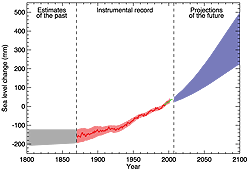Future Sea Level Rise
Higher temperatures are expected to raise sea level by:
- expanding ocean water,
- melting mountain glaciers and small ice caps,
- causing portions of the coastal section of the Greenland and Antarctic ice sheets to melt or slide into the ocean.
Higher temperatures are also likely to increase the amount of snowfall over central Greenland and Antarctica. The higher snowfall is likely to offset part of the sea level rise from other factors because the additional snow is composed of water that would otherwise be in the ocean.
Considering all of these influences, the Intergovernmental Panel on Climate Change (IPCC) estimates that the global average sea level will rise by 7.2 to 23.6 inches (18-59 cm or 0.18- 0.59m) by from 1990-2100, plus the unknown contribution from increased discharge of ice into the oceans from Greenland and Antarctica (see Figure 1).
The unknown contribution that IPCC did not attempt to estimate may be more important than what they did estimate; so IPCC has received a great deal of criticism for publishing a high scenario that omitted the most important risk. IPCC did point out that if ice flow were to increase linearly, in step with global average temperature, then sea level rise would be about 10-20 centimeters greater than assumed. But they did not actually add that estimate to their published projection, even though the US State Department and others suggested that they should. Others have not been so reluctant, but until IPCC revises its estimate of future sea level rise, it will be difficult for people along the coast to know what to make of those higher projections.
According to the IPCC, current model projections indicate substantial variability in future sea level rise between different locations. Some locations could experience sea level rise higher than the global average projection, while others could have a fall in sea level. The same factors that currently cause sea level to rise more rapidly along the Mid-Atlantic and Gulf Coasts, and less rapidly in parts of the Pacific Northwest, are likely to continue. Changes in winds, atmospheric pressure and ocean currents will also cause regional variations in sea level rise - but those variations cannot be reliably predicted.
Over time, more substantial changes in sea level are possible due to the vulnerability of the West Antarctic and Greenland Ice sheets. However, there are significant uncertainties about the magnitude and speed of future changes (IPCC, 2007):
- The West Antarctic Ice Sheet contains enough ice to raise sea level by 5-6 meters (17-20 feet). Possible instabilities in the ice sheet could allow it to slide into the oceans after a sustained warming, or if other factors raised sea level (IPCC, 2007). There is a small chance the collapse of this ice sheet could occur within a few centuries, but the response of the ice sheet to future climate change is uncertain and a subject of debate (IPCC 2007, NRC 2002).
- The Greenland ice sheet contains enough ice to raise sea level about 7 meters (23 feet). Although it is already contributing to sea level rise (from melting), it does not contain the same instabilities as Antarctica that could result in a rapid collapse. Most model projections suggest a gradual melting over millennia related to sustained climate warming (IPCC, 2007).
References
- IPCC, 2007: Climate Change 2007: The Physical Science Basis. Contribution of Working Group I to the Fourth Assessment Report of the Intergovernmental Panel on Climate Change [Solomon, S., D. Qin, M. Manning (eds.)].
- National Research Council (NRC), 2002: Abrupt Climate Change, Inevitable Surprises. National Academy Press, Washington, DC. National Academy Press, Washington, DC

